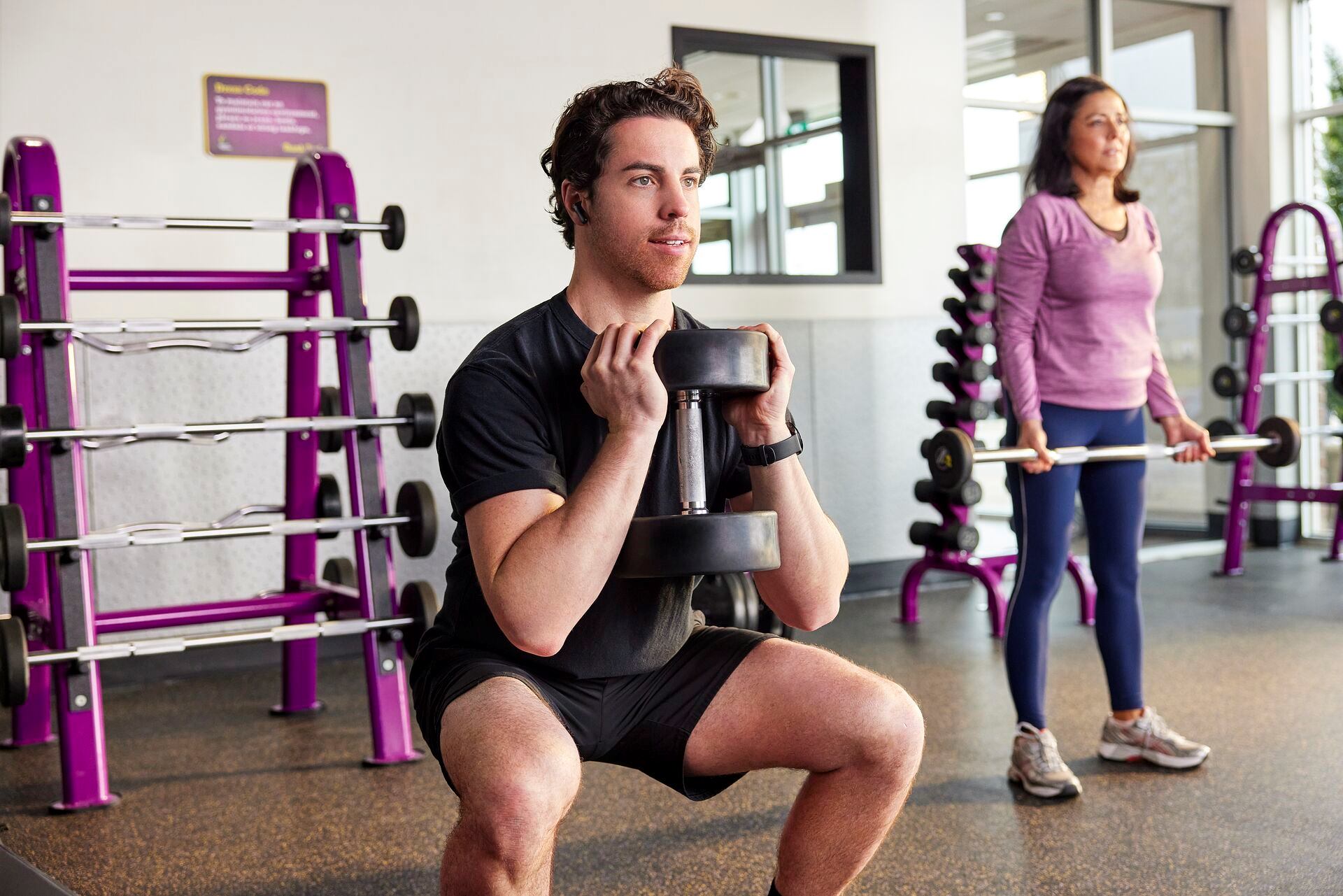Home>Misc>Featured>Which Is True Of High-Intensity Interval Training (HIIT)


Featured
Which Is True Of High-Intensity Interval Training (HIIT)
Modified: January 22, 2024
Discover the truth about high-intensity interval training (HIIT) and why it's featured as an effective workout method. Find out its benefits and how it can help you achieve your fitness goals.
Introduction
Welcome to the exciting world of High-Intensity Interval Training (HIIT)! If you’re tired of spending hours at the gym with minimal results, HIIT might just be the game-changer you’ve been looking for. HIIT has gained immense popularity in recent years due to its time-efficient nature and its ability to deliver impressive results.
But what exactly is HIIT? In simple terms, HIIT involves alternating periods of high-intensity exercise with short recovery periods. The high-intensity bursts of activity push your body to its limits, while the recovery periods allow you to catch your breath and prepare for the next round of intensity. This constant switching between high and low intensity not only keeps your body guessing but also helps you unlock a wide range of benefits.
One of the main advantages of HIIT is its time-saving aspect. Traditional forms of exercise often require long durations to achieve desired results. However, with HIIT, you can get an effective workout in as little as 20 minutes. This makes it ideal for those with busy schedules or who struggle to find the motivation for lengthy exercise sessions.
Another significant benefit of HIIT is its ability to maximize calorie burn. The intense bursts of exercise during a HIIT session push your body to work harder and burn more calories than traditional cardio exercise alone. In fact, research has shown that HIIT can increase your metabolic rate for hours after your workout, leading to continued calorie burn even when you’re at rest.
Furthermore, HIIT has been shown to be a powerful tool for improving cardiovascular health. The high-intensity intervals during a HIIT session challenge your heart and lungs, helping to improve their efficiency and endurance. This can lead to reduced risks of heart disease, improved blood pressure, and increased aerobic capacity.
But it’s not just cardiovascular health that benefits from HIIT. HIIT has also been found to be effective for muscle building and strength gains. The intense nature of HIIT activates a larger number of muscle fibers than traditional steady-state exercises, promoting muscle growth and toning. Additionally, the metabolic stress caused by HIIT triggers the release of growth hormones, further enhancing muscle development.
With all these incredible benefits, it’s no wonder HIIT has become a popular choice for individuals looking to optimize their fitness routine. In the following sections, we will delve deeper into the specifics of how HIIT can help with weight loss, cardiovascular health, and metabolic health. We will also compare HIIT to continuous moderate-intensity exercise to help you understand the unique advantages HIIT has to offer. So, let’s jump in and discover the world of HIIT!
Definition of High-Intensity Interval Training (HIIT)
High-Intensity Interval Training (HIIT) is a form of exercise that involves short bursts of intense activity followed by periods of rest or low-intensity exercise. The concept behind HIIT is to push the body to its maximum capacity during the high-intensity intervals, challenging both the cardiovascular and muscular systems, and then allowing for recovery during the rest periods.
During a HIIT workout, the high-intensity intervals typically last anywhere from 20 to 60 seconds and are performed at maximum effort. These intervals are followed by periods of active recovery or complete rest, usually lasting 10 to 60 seconds. The cycle of high-intensity activity and rest is repeated for a predetermined number of rounds or a specific duration.
The intensity of the high-intensity intervals is what sets HIIT apart from steady-state exercises. In traditional cardio workouts, such as jogging or cycling, the intensity remains relatively constant throughout. However, in HIIT, the goal is to elevate the heart rate to around 80-95% of its maximum capacity during the high-intensity intervals, pushing the body into an anaerobic state where oxygen consumption cannot keep up with the demands of the muscles.
There are various ways to incorporate HIIT into your fitness routine. It can be done through bodyweight exercises, such as burpees, jumping jacks, or high knees, or with equipment like dumbbells, kettlebells, or battle ropes. Additionally, cardio machines like treadmills, stationary bikes, or rowing machines can be used for HIIT workouts. The key is to alternate between high-intensity bursts and rest or low-intensity periods, ensuring that you challenge your body and allow for recovery.
While HIIT is known for being intense, it can be modified to suit different fitness levels. Beginners can start with shorter intervals and longer rest periods, gradually increasing the intensity and decreasing the rest time as their fitness level improves. Ultimately, the goal is to find the optimal balance between challenging yourself and maintaining proper form and safety.
It’s important to note that HIIT is not suitable for everyone. Individuals with certain health conditions, such as heart problems or joint issues, should consult with a healthcare professional before starting HIIT. Additionally, beginners should approach HIIT with caution and gradually increase the intensity and duration of their workouts to prevent injury.
In the following sections, we will explore the numerous benefits of HIIT, including its effectiveness for weight loss, its impact on cardiovascular health, its role in muscle building, and its influence on metabolic health. Additionally, we will compare HIIT to continuous moderate-intensity exercise to see how they differ in terms of results and time efficiency.
Benefits of HIIT
High-Intensity Interval Training (HIIT) offers a multitude of benefits that make it a popular exercise choice for individuals of all fitness levels. Let’s explore some of the key advantages of incorporating HIIT into your workout routine:
- Efficient Time-Use: One of the most significant benefits of HIIT is its time efficiency. Traditional exercise routines often require extended periods of time to achieve desired results. However, with HIIT, you can get a highly effective workout in a fraction of the time. A typical HIIT session can range from just 20 to 30 minutes, making it ideal for busy individuals who struggle to find time for exercise.
- Increased Caloric Burn: HIIT is highly effective for burning calories and accelerating fat loss. The intense bursts of exercise during the high-intensity intervals engage multiple muscle groups and elevate the heart rate, resulting in a higher caloric expenditure compared to traditional steady-state cardio exercises. Furthermore, HIIT has been shown to elevate the metabolic rate for several hours after the workout, leading to continued calorie burn even during periods of rest.
- Improved Cardiovascular Health: HIIT is incredibly beneficial for cardiovascular health. The high-intensity intervals challenge the heart and lungs, improving their efficiency and endurance. Regular HIIT workouts can lead to a reduced risk of heart disease, improved blood pressure, and increased aerobic capacity. Studies have shown that HIIT can be equally, if not more effective, than traditional forms of cardio exercise when it comes to improving cardiovascular fitness.
- Muscle Building and Toning: While HIIT is often associated with cardiovascular benefits, it is also an effective tool for muscle building and toning. The intense bursts of activity during HIIT sessions engage a larger number of muscle fibers compared to traditional cardio exercises, promoting muscle growth and strength. Additionally, the metabolic stress induced by HIIT workouts triggers the release of growth hormones, further enhancing muscle development.
- Increased Metabolic Rate: HIIT has been shown to have a positive impact on metabolic health. The intense nature of HIIT stimulates the production and release of growth hormones, which play a role in regulating metabolism. This can result in an increased metabolic rate and improved metabolism of carbohydrates and fats. As a result, regular HIIT workouts can help optimize metabolic function and contribute to weight management.
- Versatility and Variety: Another advantage of HIIT is its versatility. HIIT workouts can be tailored to individual fitness levels and preferences. Whether you prefer bodyweight exercises, equipment-based workouts, or cardio machines, there are endless possibilities for designing a HIIT routine that suits your needs. Additionally, the ability to vary exercise combinations and interval lengths keeps workouts exciting and prevents boredom.
With all these incredible benefits, it’s no wonder that HIIT has become a popular exercise choice for individuals looking to optimize their fitness journey. From saving time to increasing calorie burn, improving cardiovascular health, building muscle, and boosting metabolism, the advantages of HIIT are undeniable. In the following sections, we will delve deeper into the specific effects of HIIT on weight loss, cardiovascular health, muscle building, and metabolic health, comparing it to continuous moderate-intensity exercise along the way.
Effectiveness of HIIT for Weight Loss
One of the primary reasons people turn to High-Intensity Interval Training (HIIT) is its effectiveness for weight loss. HIIT workouts have been shown to be highly efficient in burning calories and shedding excess body fat. Let’s explore why HIIT is such a powerful tool for weight loss:
1. Calorie Burning: HIIT is known for its ability to maximize calorie burn in a short amount of time. The intense bursts of exercise during the high-intensity intervals elevate the heart rate and engage multiple muscle groups, leading to a higher caloric expenditure compared to traditional steady-state cardio exercises. In fact, studies have shown that HIIT can burn up to 30% more calories in a shorter duration.
2. Increased Metabolic Rate: One of the major benefits of HIIT is its ability to elevate the metabolic rate not just during the workout, but even after it ends. This is known as the “afterburn effect” or Excess Post-Exercise Oxygen Consumption (EPOC). HIIT workouts create metabolic disturbances, causing the body to consume more oxygen and burn more calories during the recovery period. This means that even after the HIIT session is over, your body continues to burn calories at an elevated rate.
3. Promotes Fat Loss: HIIT is particularly effective in targeting stored body fat. The intense bursts of exercise during the high-intensity intervals deplete glycogen stores in the muscles, forcing the body to rely more on fat as a fuel source. This can lead to a greater reduction in body fat percentage compared to steady-state cardio exercises.
4. Muscle Preservation: When trying to lose weight, it’s important to maintain muscle mass as it plays a crucial role in overall metabolic rate. Traditional steady-state cardio exercises can sometimes lead to muscle loss along with fat loss. However, HIIT is known for its ability to preserve muscle mass due to the short duration of the workouts and the metabolic stress placed on the muscles. This means that while you’re burning fat, you can also retain or even build lean muscle tissue.
It’s important to note that while HIIT is highly effective for weight loss, it’s not a magic solution. To see significant weight loss results, HIIT should be combined with a balanced diet and a healthy lifestyle. Additionally, consistency is key. Regularly participating in HIIT workouts, alongside proper nutrition, will yield the best results over time.
In comparison to continuous moderate-intensity exercise, such as jogging or cycling at a steady pace, HIIT has been found to be more effective for weight loss. Studies have shown that HIIT participants can achieve the same or greater weight loss outcomes in significantly less time compared to those engaging in continuous moderate-intensity exercise.
Overall, if weight loss is your goal, HIIT is a powerful way to melt away excess fat, boost your metabolism, and achieve a leaner physique. Combine it with a well-rounded fitness and nutrition plan, and you’ll be well on your way to reaching your weight loss goals.
Impact of HIIT on Cardiovascular Health
High-Intensity Interval Training (HIIT) not only offers a challenging workout but also provides numerous benefits for cardiovascular health. Let’s explore the impact of HIIT on the heart and overall cardiovascular fitness:
1. Improved Heart Health: HIIT workouts involve intense bursts of exercise that push the heart to work harder. This leads to an improvement in the heart’s efficiency and strengthens its ability to pump blood. With regular HIIT training, the heart becomes more adaptable and efficient, reducing the risk of cardiovascular diseases such as heart attack and stroke.
2. Increased Aerobic Capacity: HIIT is a highly effective method for increasing the body’s aerobic capacity. The intense intervals during HIIT sessions force the heart and lungs to work harder, improving their ability to transport oxygen to the muscles. Over time, this leads to an increased VO2 max, which is a measure of how well the body utilizes oxygen during exercise. By improving aerobic capacity, HIIT can enhance overall endurance and performance.
3. Lowered Blood Pressure: HIIT has been found to be effective in lowering blood pressure in individuals with hypertension. The intense intervals followed by recovery periods create a unique stimulus for the blood vessels, promoting their elasticity and improving their ability to dilate and contract. This, in turn, helps to regulate blood pressure and improves overall cardiovascular health.
4. Reduced Resting Heart Rate: Regular HIIT training has been shown to lead to a decrease in resting heart rate. This is an indication of a more efficient cardiovascular system. A lower resting heart rate signifies that the heart is strong enough to pump more blood with fewer beats, reducing strain on the cardiovascular system and improving overall cardiac health.
5. Better Cholesterol Profile: HIIT can positively impact cholesterol levels by increasing HDL (good) cholesterol and reducing LDL (bad) cholesterol and triglyceride levels. This can contribute to a healthier balance and reduce the risk of developing heart-related conditions.
6. Reduced Risk of Metabolic Syndrome: HIIT has been found to improve the markers of metabolic syndrome, a combination of conditions that increase the risk of heart disease, stroke, and type 2 diabetes. HIIT training can help improve insulin sensitivity, reduce abdominal fat, and lower blood sugar levels, ultimately reducing the risk of developing metabolic syndrome.
When compared to continuous moderate-intensity exercise, HIIT has been shown to provide equal or greater benefits for cardiovascular health. Studies have demonstrated that HIIT can improve cardiovascular fitness in a shorter amount of time compared to traditional steady-state exercises, making it an excellent choice for individuals with limited time for exercise.
Incorporating HIIT into your fitness routine can help optimize cardiovascular health, improve aerobic capacity, lower blood pressure, enhance cholesterol profile, and reduce the risk of metabolic syndrome. However, it’s important to note that individuals with pre-existing cardiovascular conditions should consult with a healthcare professional before starting HIIT to ensure safety and proper guidance.
Now that we’ve explored the impact of HIIT on cardiovascular health, let’s move on to the next section and delve into how HIIT can contribute to muscle building and strength gains.
HIIT and Muscle Building
While High-Intensity Interval Training (HIIT) is primarily known for its cardiovascular benefits, it also has a significant impact on muscle building and strength gains. Let’s explore how HIIT can help you achieve a lean, sculpted physique:
1. Activates Multiple Muscle Groups: During HIIT workouts, you engage a wide range of muscle groups, depending on the exercises performed. Movements such as burpees, squat jumps, and mountain climbers activate the lower body, core, and upper body simultaneously. This comprehensive muscle recruitment leads to overall muscle development, helping you build lean muscle mass.
2. Increased Muscle Fiber Recruitment: The intense nature of HIIT workouts triggers the activation of both slow-twitch (Type I) and fast-twitch (Type II) muscle fibers. Slow-twitch fibers provide endurance, while fast-twitch fibers contribute to power and strength. By engaging both types of muscle fibers, HIIT promotes balanced muscle development, resulting in improved overall strength and performance.
3. Metabolic Stress: The metabolic stress induced by HIIT workouts plays a key role in muscle building. During intense intervals, metabolic byproducts such as lactate accumulate in the muscles, leading to an increase in growth hormone production. Growth hormones play a critical role in muscle growth and repair, contributing to increased muscle size and strength over time.
4. Elevated Energy Expenditure: HIIT workouts elevate your heart rate and create an increased demand for energy. This means that you burn calories not only during the workout but also after the session. The high-intensity intervals followed by rest periods create an “afterburn effect” or Excess Post-Exercise Oxygen Consumption (EPOC), which can lead to continued calorie burn for several hours post-workout. This calorie expenditure supports muscle growth and maintenance.
5. Time-Efficient Muscle Building: HIIT allows you to achieve muscle-building benefits in a shorter amount of time compared to traditional weightlifting or bodybuilding routines. HIIT workouts often incorporate bodyweight exercises or compound movements that engage multiple muscle groups simultaneously. This multi-functional approach allows for efficient use of time while still targeting muscle development.
6. Adaptable to Progressive Overload: Progressive overload is a fundamental principle of muscle building. It involves gradually increasing the demands placed on the muscles over time to stimulate growth. HIIT is highly adaptable and allows you to progress by manipulating variables such as interval duration, intensity, and exercise selection. By continually challenging your muscles with more difficult HIIT workouts, you can ensure ongoing muscle growth and strength gains.
It’s important to note that while HIIT can help build lean muscle, it may not necessarily lead to significant muscle hypertrophy or “bulking” like traditional weightlifting routines. However, HIIT can still contribute to achieving a lean, toned physique by enhancing muscle definition and reducing body fat percentage.
In comparison to continuous moderate-intensity exercise, HIIT has been found to be more effective for promoting muscle growth and strength gains. The short, intense bursts of exercise during HIIT workouts create a greater stimulus for muscle growth compared to the prolonged, low-intensity nature of steady-state cardio exercises.
Now that we’ve explored the impact of HIIT on muscle building, let’s move on to the next section and delve into how HIIT influences metabolic health.
HIIT and Metabolic Health
High-Intensity Interval Training (HIIT) not only improves cardiovascular fitness and promotes muscle building but also has a positive impact on metabolic health. Let’s explore how HIIT can influence key aspects of metabolic health and contribute to overall well-being:
1. Improved Insulin Sensitivity: HIIT has been shown to enhance insulin sensitivity, which is crucial for maintaining stable blood sugar levels and preventing the onset of conditions like type 2 diabetes. Intense exercise increases the uptake of glucose by the muscles, helping to regulate blood sugar levels and improve insulin sensitivity over time.
2. Enhanced Fat Oxidation: HIIT can increase the body’s ability to burn fat as fuel. The intense intervals during HIIT workouts deplete glycogen stores in the muscles, leading the body to rely more on stored body fat for energy. This promotes fat oxidation and can contribute to a decrease in overall body fat percentage.
3. Positive Impact on Metabolism: HIIT workouts stimulate the production and release of growth hormone in the body. Growth hormone plays a significant role in regulating metabolism and promoting fat loss while preserving lean muscle mass. The release of growth hormone during HIIT is beneficial for maintaining optimal metabolic function.
4. Increased Resting Metabolic Rate: Regular HIIT training can result in an elevated resting metabolic rate (RMR). This means that even at rest, your body will burn more calories throughout the day. The intense nature of HIIT stimulates metabolic adaptations, leading to a higher energy expenditure even when you’re not actively exercising.
5. Reduced Abdominal Fat: HIIT has been found to be particularly effective in reducing visceral fat, which is the fat stored around the organs in the abdominal region. Visceral fat is closely linked to metabolic disorders and an increased risk of chronic diseases. HIIT’s ability to promote overall fat loss, combined with its impact on insulin sensitivity, makes it a valuable tool for reducing abdominal fat.
6. Lowered Inflammation: Chronic inflammation is associated with various metabolic disorders, including insulin resistance and heart disease. HIIT has been shown to reduce markers of inflammation in the body, such as C-reactive protein (CRP). By reducing inflammation, HIIT contributes to improved metabolic health and decreased risk of chronic diseases.
It’s important to note that while HIIT can have favorable effects on metabolic health, it should be combined with a balanced diet and a healthy lifestyle to optimize results. Good nutrition, adequate sleep, and stress management are all essential components of maintaining metabolic health.
Compared to continuous moderate-intensity exercise, HIIT has been found to elicit greater metabolic adaptations. The intense intervals followed by recovery periods during HIIT workouts create a unique metabolic stimulus that can result in improved insulin sensitivity, increased fat oxidation, and a higher resting metabolic rate.
Now that we’ve explored the impact of HIIT on metabolic health, let’s move on to the next section and compare HIIT to continuous moderate-intensity exercise to understand their differences in terms of results and time efficiency.
HIIT vs. Continuous Moderate-Intensity Exercise
When it comes to choosing an exercise routine, High-Intensity Interval Training (HIIT) and continuous moderate-intensity exercise are two popular options. Let’s compare the two approaches to understand their differences in terms of results and time efficiency:
Time Efficiency: One of the main advantages of HIIT is its time efficiency. HIIT workouts are typically shorter in duration compared to continuous moderate-intensity exercise. While continuous exercise may require 45 minutes to an hour, a HIIT session can range from just 20 to 30 minutes. This makes HIIT an attractive option for individuals with limited time for exercise or those who prefer shorter, more intense workouts.
Caloric Expenditure: Both HIIT and continuous moderate-intensity exercise can be effective for calorie burn. However, due to its high-intensity nature, HIIT generally burns more calories in a shorter amount of time. The intense intervals during HIIT elevate the heart rate and engage multiple muscle groups, leading to a higher caloric expenditure both during and after the workout. Continuous moderate-intensity exercise can still provide effective calorie burn, but it may require a longer duration to achieve similar results.
Cardiovascular Fitness: Both HIIT and continuous moderate-intensity exercise are beneficial for cardiovascular fitness, but they target different aspects. HIIT is known for its ability to improve anaerobic fitness, pushing the heart and lungs to their limits. On the other hand, continuous moderate-intensity exercise mainly focuses on improving aerobic endurance. The choice between the two depends on individual goals and preferences.
Muscle Building: While not the primary focus, both HIIT and continuous moderate-intensity exercise can contribute to muscle building. HIIT engages multiple muscle groups during the intense intervals, leading to overall muscle development. However, if significant muscle hypertrophy is the goal, traditional strength training exercises with heavier weights may be more effective. Continuous moderate-intensity exercise can still provide some muscle toning and endurance benefits.
Variety: HIIT offers a wide variety of exercises and intervals, allowing for a more diverse and dynamic workout experience. This can help prevent boredom and keep individuals motivated. Continuous moderate-intensity exercise, such as jogging or cycling at a steady pace, may offer less variety but still provides the opportunity for mindfulness and a steady rhythm for some individuals.
Adaptability: Both HIIT and continuous moderate-intensity exercise can be adapted to different fitness levels. HIIT allows for modifications in interval duration, intensity, and exercise selection to suit individual needs. Continuous moderate-intensity exercise can be adjusted by varying the speed, resistance, or incline. This adaptability makes both approaches accessible to beginners and challenging for more advanced individuals.
In summary, both HIIT and continuous moderate-intensity exercise have their merits. HIIT is known for its time efficiency, high caloric burn, and ability to improve anaerobic fitness, making it ideal for those with limited time or seeking intense workouts. Continuous moderate-intensity exercise is best suited for those who prefer longer-duration, steady-state workouts that improve aerobic endurance. It’s important to choose the approach that aligns with your goals, preferences, and overall fitness level.
Now that we have compared HIIT to continuous moderate-intensity exercise, let’s move on to the next section to explore some safety considerations for HIIT workouts.
Safety Considerations for HIIT
While High-Intensity Interval Training (HIIT) offers numerous benefits, it’s important to approach it with caution and prioritize safety. Here are some key considerations to keep in mind when engaging in HIIT workouts:
1. Proper Warm-Up: Before starting a HIIT session, it’s crucial to warm up adequately. A warm-up prepares the body for the intense exercise that follows, increasing blood flow to the muscles and reducing the risk of injury. Incorporate dynamic stretches, light cardio exercises, and mobility drills to warm up the major muscle groups and joints.
2. Gradual Progression: If you’re new to HIIT or returning from a break, it’s important to gradually progress your workouts over time. Start with shorter intervals and longer rest periods, gradually increasing the intensity and decreasing the rest time as your fitness level improves. Avoid the temptation to push yourself too hard too soon, as it can lead to overexertion and potential injury.
3. Proper Form and Technique: Ensure that you maintain proper form and technique during every exercise. Performing exercises with incorrect form can not only limit the effectiveness of the workout but also increase the risk of injury. If you’re unsure of the proper form, consider seeking guidance from a certified fitness professional or using reliable instructional resources.
4. Listen to Your Body: Pay attention to your body’s signals during a HIIT workout. While it’s normal to feel challenged and push your limits, it’s equally important to know when to take a break or modify an exercise. If you experience sharp pain, dizziness, shortness of breath, or excessive fatigue, it’s best to stop and seek medical attention if necessary.
5. Recovery and Rest: Allow sufficient time for recovery and rest between HIIT sessions. The intensity of HIIT workouts places significant stress on the muscles, joints, and cardiovascular system. Adequate rest allows the body to repair and rebuild, reducing the risk of overuse injuries and maintaining overall health and performance.
6. Individual Considerations: Consider your individual fitness level, health conditions, and any pre-existing injuries when engaging in HIIT workouts. It’s crucial to consult with a healthcare professional if you have any concerns or medical conditions that may affect your ability to safely participate in high-intensity exercise.
7. Hydration and Nutrition: Stay properly hydrated before, during, and after HIIT workouts. Dehydration can impact performance and increase the risk of injury. Additionally, ensure you have a balanced diet that provides adequate nutrients to support your energy needs and aid in recovery.
8. Variety and Cross-Training: Avoid excessive repetitive movements by incorporating a variety of exercises and activities into your fitness routine. Cross-training and including other forms of exercise can help prevent overuse injuries and promote overall strength and conditioning.
By following these safety considerations, you can minimize the risk of injury and maximize the benefits of HIIT. Remember, everyone’s fitness journey is unique, so it’s important to listen to your body and make choices that align with your individual needs and capabilities.
Now that we’ve covered safety considerations, let’s move on to the recommended structure for a HIIT workout.
Recommended HIIT Workout Structure
When it comes to structuring a High-Intensity Interval Training (HIIT) workout, there are various approaches you can take. The key is to design a workout that challenges you, maximizes calorie burn, and allows for effective recovery. Here’s a recommended structure for a HIIT workout:
1. Warm-up: Begin with a dynamic warm-up to prepare your body for the upcoming intense exercise. This can include exercises such as jogging in place, arm circles, high knees, and leg swings. Aim for 5-10 minutes of light cardio and mobility drills targeting major muscle groups and joints.
2. Interval Duration: Determine the duration of your high-intensity intervals based on your fitness level and goals. Start with shorter intervals, around 20-30 seconds, if you’re new to HIIT or gradually increase the time to 45-60 seconds for more advanced individuals. The higher the intensity, the shorter the interval duration should be.
3. Rest or Active Recovery: After each high-intensity interval, allow for a period of rest or active recovery. The rest period can range from 10-60 seconds, depending on your fitness level and the intensity of the interval. During the rest period, actively recover by performing low-intensity exercises, such as walking or slow jogging, to keep your heart rate elevated and maintain blood flow to the muscles.
4. Exercise Selection: Choose a variety of exercises that target different muscle groups. This will ensure overall muscle engagement and prevent muscle fatigue. Incorporate both bodyweight exercises and equipment-based exercises to keep the workout diverse and challenging. Examples include burpees, jumping lunges, push-ups, kettlebell swings, or box jumps. Aim for 4-6 different exercises per workout.
5. Number of Rounds/Duration: Determine the number of rounds or the total duration of your HIIT workout based on your fitness level and time availability. Start with 2-3 rounds if you’re a beginner or gradually increase to 4-5 rounds for more advanced individuals. Alternatively, you can set a total duration for your workout, such as 20-30 minutes, and perform as many rounds as possible within that time frame.
6. Cool-down and Stretching: Conclude your HIIT workout with a cool-down period to bring your heart rate back to normal and allow your body to gradually recover. This can include 5-10 minutes of low-intensity cardio, followed by static stretching targeting major muscles to improve flexibility and prevent muscle tightness or soreness.
7. Progression: Over time, aim to progressively increase the intensity, duration, or number of rounds in your HIIT workouts. This will challenge your body and prevent plateauing. However, remember to listen to your body and progress gradually to avoid overexertion or risk of injury.
Remember, it’s essential to personalize your HIIT workouts based on your fitness level and individual goals. Adjust the intensity, duration, or rest periods as needed to challenge yourself while maintaining proper form and safety. Don’t be afraid to experiment with various exercises, intervals, or workout structures to keep your workouts engaging and effective.
Now that we’ve covered the recommended HIIT workout structure, let’s summarize the key points and conclude our exploration of HIIT.
Conclusion
High-Intensity Interval Training (HIIT) is a highly effective exercise approach that offers a multitude of benefits. It provides a time-efficient way to burn calories, improve cardiovascular fitness, build muscle, and enhance metabolic health. HIIT workouts involve short bursts of intense activity followed by periods of rest or low-intensity exercise, making them a versatile and adaptable option for individuals of all fitness levels.
By incorporating HIIT into your fitness routine, you can achieve remarkable results in a shorter amount of time compared to traditional exercise approaches. HIIT promotes weight loss by increasing calorie burn, boosting metabolism, and preserving muscle mass. It also benefits cardiovascular health by improving heart efficiency, increasing aerobic capacity, and lowering blood pressure.
Moreover, HIIT contributes to muscle building and strength gains by activating multiple muscle groups, increasing muscle fiber recruitment, and promoting metabolic stress. It also enhances metabolic health by improving insulin sensitivity, enhancing fat oxidation, and lowering inflammation.
When engaging in HIIT, it’s important to prioritize safety. Follow proper warm-up protocols, progress gradually, maintain good form and technique, listen to your body, and allow for adequate recovery. Additionally, consider individual factors such as fitness level, pre-existing conditions, hydration, nutrition, and the importance of variety and cross-training.
To create an effective HIIT workout, structure your sessions with a warm-up, defined intervals of high-intensity exercise and recovery, a variety of exercises targeting different muscle groups, and a cool-down with stretching. Progression over time is crucial to avoid plateaus and continue challenging your body.
In conclusion, HIIT is a dynamic and efficient fitness approach that can transform your workouts and help you achieve your fitness goals. Whether you’re looking to lose weight, improve cardiovascular health, build muscle, or enhance metabolic health, HIIT is a versatile and effective option worth incorporating into your fitness routine. So, lace up your sneakers, embrace the intensity, and start reaping the incredible benefits of HIIT!









